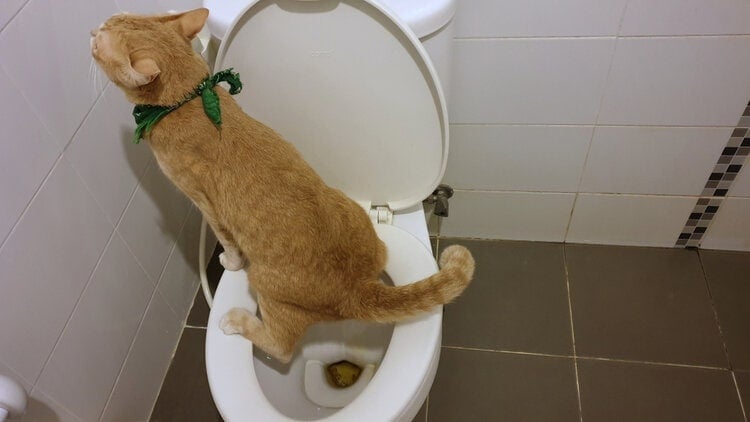Prevent Plumbing Problems: Don't Flush Cat Poop Down Your Toilet - Professional Advice
Prevent Plumbing Problems: Don't Flush Cat Poop Down Your Toilet - Professional Advice
Blog Article
In this article in the next paragraph you can locate additional sound information about Can You Flush Cat Poop Down The Toilet?.

Intro
As feline owners, it's vital to bear in mind just how we dispose of our feline friends' waste. While it might appear hassle-free to flush pet cat poop down the bathroom, this practice can have harmful repercussions for both the atmosphere and human wellness.
Alternatives to Flushing
The good news is, there are safer and much more accountable methods to take care of cat poop. Take into consideration the complying with options:
1. Scoop and Dispose in Trash
The most usual technique of throwing away pet cat poop is to scoop it into a biodegradable bag and toss it in the garbage. Make certain to make use of a devoted litter scoop and get rid of the waste without delay.
2. Use Biodegradable Litter
Choose naturally degradable cat clutter made from products such as corn or wheat. These trashes are eco-friendly and can be safely gotten rid of in the garbage.
3. Bury in the Yard
If you have a lawn, consider burying feline waste in an assigned area far from veggie yards and water sources. Be sure to dig deep enough to prevent contamination of groundwater.
4. Install a Pet Waste Disposal System
Invest in a pet dog waste disposal system particularly made for cat waste. These systems use enzymes to break down the waste, lowering smell and ecological influence.
Health and wellness Risks
In addition to environmental worries, flushing feline waste can likewise present wellness risks to humans. Cat feces might have Toxoplasma gondii, a parasite that can cause toxoplasmosis-- a possibly severe illness, especially for expecting females and individuals with weakened body immune systems.
Environmental Impact
Flushing feline poop presents damaging virus and bloodsuckers into the supply of water, posturing a significant risk to aquatic environments. These impurities can adversely impact marine life and compromise water quality.
Conclusion
Responsible animal ownership extends beyond offering food and shelter-- it also involves proper waste management. By refraining from purging pet cat poop down the bathroom and selecting alternate disposal methods, we can minimize our ecological impact and safeguard human health.
Why Can’t I Flush Cat Poop?
It Spreads a Parasite
Cats are frequently infected with a parasite called toxoplasma gondii. The parasite causes an infection called toxoplasmosis. It is usually harmless to cats. The parasite only uses cat poop as a host for its eggs. Otherwise, the cat’s immune system usually keeps the infection at low enough levels to maintain its own health. But it does not stop the develop of eggs. These eggs are tiny and surprisingly tough. They may survive for a year before they begin to grow. But that’s the problem.
Our wastewater system is not designed to deal with toxoplasmosis eggs. Instead, most eggs will flush from your toilet into sewers and wastewater management plants. After the sewage is treated for many other harmful things in it, it is typically released into local rivers, lakes, or oceans. Here, the toxoplasmosis eggs can find new hosts, including starfish, crabs, otters, and many other wildlife. For many, this is a significant risk to their health. Toxoplasmosis can also end up infecting water sources that are important for agriculture, which means our deer, pigs, and sheep can get infected too.
Is There Risk to Humans?
There can be a risk to human life from flushing cat poop down the toilet. If you do so, the parasites from your cat’s poop can end up in shellfish, game animals, or livestock. If this meat is then served raw or undercooked, the people who eat it can get sick.
In fact, according to the CDC, 40 million people in the United States are infected with toxoplasma gondii. They get it from exposure to infected seafood, or from some kind of cat poop contamination, like drinking from a stream that is contaminated or touching anything that has come into contact with cat poop. That includes just cleaning a cat litter box.
Most people who get infected with these parasites will not develop any symptoms. However, for pregnant women or for those with compromised immune systems, the parasite can cause severe health problems.
How to Handle Cat Poop
The best way to handle cat poop is actually to clean the box more often. The eggs that the parasite sheds will not become active until one to five days after the cat poops. That means that if you clean daily, you’re much less likely to come into direct contact with infectious eggs.
That said, always dispose of cat poop in the garbage and not down the toilet. Wash your hands before and after you clean the litter box, and bring the bag of poop right outside to your garbage bins.
https://trenchlesssolutionsusa.com/why-cant-i-flush-cat-poop/

I stumbled upon that entry on How to Dispose of Cat Poop and Litter Without Plastic Bags while doing a lookup on the web. Sharing is good. Helping others is fun. Thanks a lot for your time. Visit again soon.
This Website Report this page